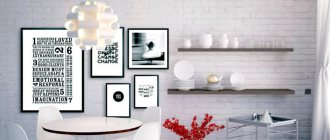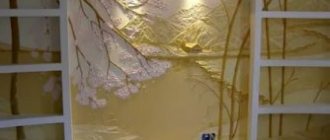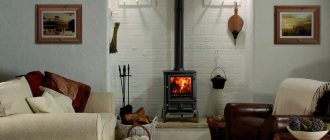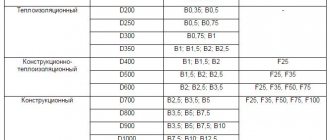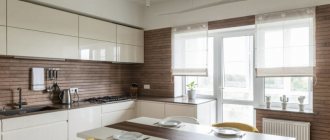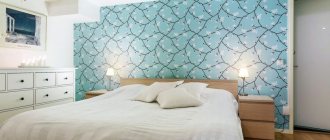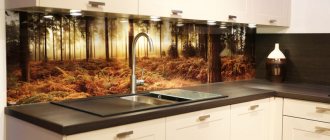White wall
White interiors have remained fashionable for several years now. A whitewashed brick wall is a great way to add a curious twist to this trend. The Izolux construction hypermarket has fashionable options in a white palette.
Photo: ofdesign.net
Gypsum brick
This material is considered the most inexpensive, practical, durable and reliable. And also do not forget about the variety of textures and sizes of the resulting masonry. Another advantage of gypsum stone for brick is the absence of deformation due to temperature changes.
Gypsum decorative brick is resistant to temperature changes
Important: But such bricks cannot boast of moisture resistance. Absorption can only be avoided by applying a special protective coating to the surface - varnish or paint.
According to the texture and appearance of the surface, gypsum decor can be:
Matte - always treated with special means to protect the stone from destruction and water ingress. Naturally, it has no shine.
Matte decorative gypsum brick
Glossy – has a beautiful, even shine. It must be varnished, which provides a wonderful shine effect.
For shine, gypsum brick is coated with varnish
Torn - the finish does not have a flat surface, but is created as a chaotic arrangement of corners and roughness.
Torn decorative brick for interior decoration
Relief – the surface is made using a variety of relief overlays.
Decorative brick with relief overlays
Convex or concave - creates a three-dimensional effect due to such an unusual shape.
This finishing material has several features that should definitely be taken into account when choosing a material for finishing rooms. In addition to its affordable price, which attracts consumers, it should be noted:
- Various dimensional solutions.
- To save a lot of money, you can create gypsum decorative material yourself.
Manufacturing process
There is nothing difficult about using self-made gypsum products to cover your walls. By following simple manufacturing instructions, you can make as many decorative bricks as you need for repairs.
What will be needed for production?
Ordinary gypsum dough - you can buy it at any hardware store.
Gypsum for decorative bricks
To cast each brick you will need molds - you can make them yourself or purchase them at a retail outlet. You select the dimensions yourself, depending on the area calculations and the desired design effect.
An example of a mold for casting decorative bricks
A lubricant that allows the finished product to be pulled out of the mold.
A special hardener for gypsum mortar - so that the process goes faster, and the finished brick is durable and does not crumble.
Hardener for gypsum mortar
Pigments for painting in the desired color - you can leave it snow-white, but this shade will not last long enough (impurities will be clearly visible).
Let's start making!
To knead gypsum dough, you should gradually pour purchased gypsum powder into a container with hot (not cold or warm) water and stir it constantly. The ratio of water and gypsum should be indicated on the packaging of the powder mass.
A special construction mixer will help speed up the process as much as possible and save a lot of time, which can mix even large volumes in a few minutes.
A construction mixer will speed up the process of preparing the solution
If you decide to give the brick a certain color, then the coloring pigment must be added during the mixing process and thoroughly dissolved.
Tip: Do you want to leave beautiful and unusual patterns of color on the surface of decorative brick? Then pour in the color last and stir just a little until multi-colored stripes remain.
After thorough mixing, pour the solution into thoroughly greased molds. The hardening time will depend on the size of the mold itself, so you should check the readiness after one day of standing in the mold. After complete hardening, you can remove the finished product using a rubber hammer.
Pouring plaster into a mold
Tip: While the gypsum decorative brick is in the mold, it can be coated with varnish or other protective agent. This way you don’t have to worry about damage during installation.
Due to its lightness, ease of installation and excellent appearance, gypsum decorative brick is constantly gaining more and more popularity. Many have already made their choice in favor of this material and are enjoying a durable and beautiful coating on their walls.
Ready-made decorative gypsum brick
Brick “ribbon” between windows
If you have several windows in a room, you can decorate the space between them with brickwork. This will give the interior a special mood and a modern look. The Slavdom store has good options for implementing this idea.
Photo: renoguide.com.au
What does stone look like in the interior?
Sometimes you shouldn’t focus solely on any one finishing material. Try playing with combinations. The photo shows an example of an excellent combination of artificial stone and wallpaper within the same hallway.
We have already noted how great mirrors highlight the stone texture and expand the space. Let's make sure of this again.
Another example of a modern interior, freed from unnecessary design stereotypes. A spacious, bright hallway, in which both artificial stone and discreet wallpaper on the walls feel equally comfortable.
If you live in a private house, then this accommodation option can be considered suitable for you.
To create the illusion of expanding space, it is not enough just to use a mirror surface. The mirror requires special placement - the photo shows a version of a cramped Khrushchev building, the owners of which tried to use a well-known design trick. Did it work or not?
The light sandstone works great to create a light and airy atmosphere in this hallway.
Old England stone appears more and more often in photographs of modern apartments.
We noted above that stone in the hallway is often used to create an accent on some element of the interior. In this photo, the owners used it to finish the door slopes and went slightly beyond the opening, creating a classic herringbone pattern.
The situation is similar in this example. Stone is not the main finishing material, but serves as an excellent tool for giving the room additional expressiveness.
Sometimes it is worth showing courage and a certain courage to put such design solutions into practice. Smooth out the corners, replacing strict geometry with classical motifs - why not?
If the artificial stone in your hallway is complemented by ceramic granite flooring with a similar texture, the room acquires a pleasant solidity and attractive coldness.
An example of how you can use stone in a hallway without seeming banal. Typically, such decoration gives the room more solidity and, perhaps, darkness. But in the photo everything is quite the opposite, right?
Small shelves with photographs against a background of laid stone are a good way to refresh the interior.
A built-in mirrored wardrobe in the hallway will not only save you space, but will also visually expand the space, reflecting the stonework on the wall opposite.
Some small souvenirs can sometimes add a bit of freshness and pleasant shine to your room.
A harmonious combination of stone in the hallway with urban-themed photo wallpaper. If you are going to decorate an arch, use a stone texture to emphasize its noble status.
An example of a hallway where the stone wall decoration is so perfect and thought out to the smallest detail that you want to sing an ode to the designer who created this unique project.
Some owners manage to make a real revelation out of their hallways. Of course, it will no longer be possible to surprise with a stone in the hallway, but it is quite possible to make an impression with its non-standard arrangement. By moving away from the usual design clichés, you can achieve the most incredible results. The photo below is the most convincing proof of this.
Summary: There are many options for decorating the walls of the hallway, but if you prefer to see stone in it, you will never go wrong. Today, this is one of the most economical and effective ways to achieve greater expressiveness and serene cold beauty from the interior of your room. Ultimately, it all depends on your choice, and the above photos of stone wall decoration, we dare to hope, will allow you to do it correctly.
Don't like the stone? What does decorative plaster look like in the hallway?
Photo: moreidei.ru, ok.ru, uhouse.ru, vk.com, forumhouse.ru
motley wall
A brick wall can be one color; it’s good to create entire paintings on it, or you can make it a palette where one shade smoothly transitions into another. You can find just such material for the wall and paint it to your taste.
Calculate the exact cost of repairs using an online calculator
and receive a free detailed estimate for repairs
Calculate
Photo: rosegal.com
Artificial gypsum brick
Artificial brick made from gypsum is an excellent material that has many positive aspects, among which the following stand out:
Dimensions of artificial bricks.
- practicality;
- reliability;
- durability;
- light weight;
- wide range of models;
- low cost.
All these advantages, and especially the relatively low price of white gypsum brick and its multi-colored analogues, have made such products in demand in the modern market. At the same time, such material also has some negative aspects, which does not make it possible to use such products in places with high humidity. One of the similar qualities is high moisture absorption due to the porosity of gypsum. As a result of exposure to water, it can become almost completely wet, deforming and changing its structure. Based on this, it follows that after its immediate installation, gypsum artificial brick requires additional processing aimed at increasing its service life.
Installation diagram of artificial brick.
Today, there are the following types of gypsum decorative bricks, differing in their shape, texture and coating structure:
- matte;
- glossy;
- torn;
- embossed;
- convex.
Such versatility allows this material to be used to create a variety of interior solutions in almost any room characterized by dryness and constant temperatures. There is also the opportunity to create bricks for interior decoration with your own hands, thereby saving a significant amount of material resources.
